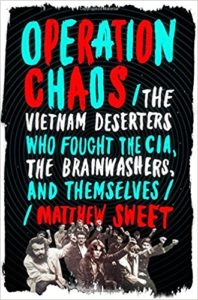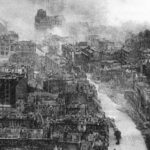One February morning, shortly before I became part of the queen’s secret plot to start World War III, I knocked on the door of a retired Catholic schoolteacher in the wealthiest county in the United States. His home—large, elevated, comfortable—rose from the snow-covered ground of Loudoun County,Virginia, a region populated by civil servants, senators, and spies. The cold heart of America.
There was no answer. I kicked the snow from my boots, watched my taxi disappear down the dirt road, peered through the window, and met the gaze of a plaster saint perched on the sideboard. Jim McGourty had sounded nervous on the phone, and I feared he’d changed his mind about our interview. It had taken weeks of negotiation through a third party and came with a condition attached: that I would refer to him only by his nom de guerre. The man inside this house was not the real Jim McGourty. The real one had been dead before his second birthday. But in 1970, the first facts of his little life were resurrected, inscribed in a new passport, and used to bring an American fugitive back to his homeland. Back from exile, to take control of the United States. And then the world. And then the planet Mars.
Like many of the people enmeshed in these events, Jim had no obvious reason to talk to me, and many to keep silent-not least the presence of those civil servants, senators, and spies. I wouldn’t have blamed him for getting cold feet. Many of his former comrades had ignored my letters and emails. Some, when I reached them by phone, appeared to suffer sudden attacks of amnesia—or insisted that they were a different person with the same name.
Others made it clear that my request for an interview was about as welcome as an envelope of compromising photographs. “I do not wish to be defined by my past,” read one whiplash reply from an American author who, in a former life, was smuggled from Tokyo to Moscow with the help of the KGB. (The story of his court-martial and his UFO encounters must be told instead by those who knew him.)
“I would be reluctant to participate in this project on any basis,” wrote an American academic dismayed to be reminded of the time when he fought the same fight as Jim McGourty. (No firsthand account from him, then, of the nights he and his friends kept a woman imprisoned in her Manhattan apartment, playing Beethoven in an attempt to reprogram her brain.) Another witness, whose name I gleaned from a CIA surveillance report, agreed to have a drink with me in order to offer his discouragement. “I had dinner with some of the other guys last night and we agreed that none of us should speak to you,” said the former high school principal, when we met under the eye of the clock at Stockholm Central Station. “Keep my name out of it.” He was so agitated that he spilled his Diet Coke all over the cafe table.
It was Christina, Jim’s wife, who heard me knocking and invited me in from the snow. A tall, immaculate woman in her sixties. “I know the English have tea at three,”she said. And there it was, laid out on the table in the music room at the back of the house. Finger sandwiches, crudites, slices of fruitcake. Beside it, in the corner armchair, was her husband, a soft-spoken man in the plaid shirt and slacks that are the uniform of retired Americans the world over. He had a folder of notes laid out on his knee. Dates, names, the details in proper order, as if he were preparing to teach a class on his own past. I asked him why he wanted to tell his story. He furrowed his brow. Perhaps, he reasoned, it would be a way of explaining himself to his estranged son, the offspring of his first marriage. Maybe the boy would read it and better understand his father’s motives—the road he took at the end of the 1960s from protest against an unjust war to participation in something darker and more outlandish.
Certainly there was much to understand. Half a century later, some of it was still unclear to Jim. “I didn’t intend to do anything against the government,” he said, tears swimming in his eyes, “but then Bobby Kennedy was shot. Martin Luther King was shot. And I didn’t feel the sense of security that I had before.”
That anxiety brought him to the decision that forms the common link among most of the people in this story. It was the choice upon which an American generation was skewered: whether to accept a kind invitation from the government to fight in the Vietnam War or to decline that offer and accept the consequences. Many men refused and suffered little. But Jim was part of a group that trod a more difficult path. Men who were already in uniform. Men who deserted from the military and went into exile in Sweden, the only non-Communist country in Europe that offered asylum to those who refused to fight.
Jim could recount his steps toward that choice. He could remember the sinking feeling of knowing that he was to be sent from his desk job into action on the front line. He could give a good and comprehensible account of his arrival in Stockholm, the life he led among the thousand strong community of deserters and draft resisters who’d made the same decision; how he’d become a prominent member of the American Desert ers Committee, a group of radical exiles who sowed so much discord that many Swedes suspected they were a CIA front. Other details, though, were less sharply focused. How had he become a revolutionary, living underground in 1970s America? What about the business with the nunchakus? Or his prison sentence? Or the phalanx of Cuban frogmen lurking in the Hudson River, waiting for the order to kill? What about the men from Operation Chaos?
Jim McGourty was right to be confused. His life remains part of a story that began fifty years ago but has never quite ended, thanks to the unhealed wounds of Vietnam, the secret strategies of the American and Swedish intelligence services, and the influence of a cult run by one of the weirdest personalities in American political history—a management consultant from New Hampshire who, even today, at the age of ninety four, wants you to know that Britain started the Vietnam War, that the Beatles were created as an instrument of psychological warfare, and that he is the only man in the world who can save you, me, Jim, Christina, and everyone from the genocidal ambitions of Her Majesty Queen Elizabeth II.
“So,” said Christina, with the directness of someone who has spent a career as a professional copy editor. “How are you going to structure this? What are you going to begin with?”
“Maybe,” I said, “with the brainwashing part. The moment when everything went nuts.”
***
It happened in the Marc Ballroom, a shabby venue on the west side of Union Square in Manhattan, on January 3, 1974. In those days, New York was a city sliding toward bankruptcy. Thanks to the oil crisis, it was also brutally cold. Gas stations across America were closed for business. Speed limits were brought down to reduce fuel consumption.
Thermostats were dialed down, store windows darkened early. Inside the ballroom, they were already shivering. The events of that night would be beyond reconstruction, had Christina not been present, taking notes—and had the political organization to which she and Jim belonged not had a mania for converting its proceedings into print. Despite its achingly dull name, the National Caucus of Labor Committees had no qualms about publishing sensational accounts of its own crises. They were spelled out in press releases and telegrams to the White House. They were spun from mimeograph machines and sold on the streets in ten-cent installments, then typeset for the pages of its newspaper, New Solidarity. The atmosphere in the Marc Ballroom was panicky and febrile. Many in the crowd were NCLC delegates enduring their fourth consecutive sleepless night. The rest were journalists, activists, and members of the public who had been summoned by flyers that promised to blow the whistle on the greatest con spiracy of modern times–“the takeover by the CIA of the United States of America.”
At eight p.m., the head of the NCLC swept into the room—a sharp eyed, tweedy, balding figure a good two decades older than the students and twentysomethings who formed his audience. They called him Lyn Marcus—an alias he’d been using since 1949. In recent months, however, he had begun referring to himself as Der Abscheulicher, the Abominable One-a name that nobody had called him when he was giving marketing advice to the footwear industry. As he went to the lectern, Marcus hushed the applause.
“Don’t get freaked out by anything,” he said, “but I don’t want to create conditions which are not healthy for one or two individuals in the group here. I’m going to give you the worst part of the thing as well as the best so that there’s no question in your mind that I’ve given the whole scoop. We are now in the second phase of a psy-war game designed by the CIA, that is, a psychological warfare game conducted on a scale of four continents.” Everybody, quite naturally, freaked out.
The Central Intelligence Agency—the state body tasked with gathering, processing, and analyzing national security information from around the world—had, he explained, turned some of their most trusted colleagues into killers.The Central Intelligence Agency—the state body tasked with gathering, processing, and analyzing national security information from around the world—had, he explained, turned some of their most trusted colleagues into killers. It had drugged them, imprisoned them, reconditioned their minds, erased their memories of the experience, and returned them to their friends as unknowing vehicles of a murderous conspiracy. The principal victims, Marcus explained, were now confined in a number of apartments across Manhattan, where their programming had been broken and the details of the plot had come tumbling out. One had spoken of “Operation Chaos and Confusion.” Another had been reduced to babbling in computer code—the language in which his instructions had been implanted. “This isn’t speculation,” Marcus insisted. “No guessing. This is hard fact. We know it.”
The theater of operations had many scenes: a submarine lurking in New York Harbor; a hotel near Gatwick Airport at which the guests were spies; a classroom in a North London school where the only pupils present were not real but photographs.
The big opening number of the conspiracy, however, had been performed at a secret facility near Stockholm. Here, Marcus explained, brainwash candidates had been put under hypnosis, subjected to electric shocks, forced to eat their own excrement and endure sexual humiliation, and tortured until they whined like puppies. Once they had been reduced to mental pulp, the programming began. A literal kind of programming, following the rules of the computer age. Numbers linked to functions. Infinite loops of coded instructions, drilled into the subject by repetition, violence, the application of electrodes to bare skin. Finally, cyanide pills had been secreted inside their bodies, in order to eliminate the killers once they had fulfilled their programs. “We have the scoop,” declared Marcus, “on one of the nastiest, most vicious CIA operations-the brainwashing institutes of Sweden. It’s a great place to go for a vacation. But don’t eat anything, don’t drink anything. You may not come back a man, or a woman.”
As he neared the end of his speech, Marcus looked around the room. There might, he suggested, be sleeper agents among the audience. Manchurian candidates, conditioned to kill. Questions from the floor, therefore, would be taken in written form, to prevent the accidental utterance of a trigger word that would activate the program and bring bloodshed to the ballroom. “It is a crisis situation,” he said. “We are in class war. No significant shooting has started here yet. Shooting will occur.People will be killed. People will suffer brainwashing.”
“Perfectly sane people were saying that they had been brainwashed,” recalled Christina. “It just kept getting weirder and weirder.”As, in the course of the following three years, it would for me.
***
This is a story of impossible things, and how a group of men came to live their lives by them because they did not want to die in Vietnam. It is about how it felt to be faced with the great moral decision of the age, and the terrible consequences that came from calling it right. It is about how being paranoid doesn’t mean they’re not out to get you.
It contains imagined conspiracies and real ones. Some of the people you will meet are telling the truth. Some of them are liars. I belong in the former category, but I’ll understand if you have your suspicions. A few of my interviewees certainly did. “The same CIA operatives have been working for years,” raged one Stockholm deserter, in an email from Hawaii. “I am not sure about YOU.”
I had a growing sense that I was exploring events that were mysterious even to those who had actually experienced them—and that those mysteries were now exerting their power over me.That uncertainty, and how to live with it, also became a subject of the story. I was getting to know a band of comrades who had made a stand against an unjust conflict and came to believe, almost immediately, that enemy infiltrators were operating among them. Nearly fifty years later, documents released by the intelligence archives of America and Sweden suggested that this suspicion was well founded. But the names of the informants had been redacted from the files. As they entered their seventies, the deserters faced the possibility that life for them was an espionage whodunit from which someone had torn the last page-the one that revealed which of their friends had sold them out to the spooks. Except that the story was too strange for any spy novel. As time went on, I realized that I had joined something much weirder than a fifty-year old mole hunt. Moles are unsensational creatures. They snuffle about. They dig tunnels. They make molehills. I was on the trail of fantastic beasts.
In their teens and twenties, the figures at the heart of this story were American boys who felt the eye of war upon them and went to Sweden to escape its gaze. They joined the American Deserters Committee, a noisy and radical political organization that proved a thorn in the side of the Swedish political establishment. Then, tired of marching through Stockholm under earnest slogans about U.S. imperialism, they became revolutionaries and dreamed of taking over America and Europe, as the Bolsheviks had taken power in Russia. But the National Caucus of Labor Committees was not the Bolsheviks. It was an apocalyptic cult that believed in the satanic nature of the Queen of England, the prime minister of Sweden, and the Beatles and used violence, harassment, and financial fraud to achieve its goals. Goals that its successor organization is still working to accomplish.
This is not the story I intended to write. At first I planned a grand historical survey of the act of desertion from the Second World War to the present day. I went down to St. Paul’s Cathedral in London, where deserters from Iraq and Afghanistan were among the protestors living under the nylon tents of the Occupy camp. I read about the handful of American and British men who crossed the lines into North Korea and, because they were among the only white inhabitants of a closed state, were cast as the villains in Nameless Heroes, Pyongyang’s answer to the James Bond films. (YouTube will satisfy the curious.) I visited the retired British gangster “Mad” Frankie Fraser, whose desertion and housebreaking during the Second World War had put him in Wormwood Scrubs prison alongside the stage and screen star Ivor Novello. (“As Ivor passed down the landing,” he recalled, “all the prisoners came to their cell doors and sang ‘We’ll Gather Lilacs.'”)
But the Vietnam deserters who went to Stockholm began to push these other figures from my mind. Partly because their very existence, once front-page news all over the world, was so little remembered beyond Sweden, and only hazily there. Partly because death was beginning to silence them and lock away their stories. Mainly, though, because I had a growing sense that I was exploring events that were mysterious even to those who had actually experienced them—and that those mysteries were now exerting their power over me.
As I talked to the survivors of the American Deserters Committee, I heard them puzzle over incidents that remained undiscussed with friends, with children, with the spouse sleeping in the next room. I heard them voice doubts about the gaps in their memories, express bewilderment at the actions of the people they had once been. I became fascinated, too, by what they wanted from me—renewed contact with long-lost comrades; the opportunity to kick against press reports about their conduct; the means to settle an old score; some help to discover, fifty years on, who had been loyal and truthful, and who had secretly betrayed them. And in some cases, it was much simpler. All they wanted was a bit of company, and a free lunch to make the food stamps stretch a bit further.
The pursuit of their stories took me to a cannabis refinery in Eugene, Oregon, and a maximum-security prison in Taylorsville, North Carolina. I met my subjects in parking lots and cafes; waited in hotel lobbies in Sweden and the States to keep appointments with former intelligence officers. I made a nuisance of myself at a prestigious Washington think tank and attended a cult meeting in the basement of a New York hotel. The story worked its way into my bones. I began dreaming of confrontations with the men who seemed to be the villains of the piece. I found myself awake at three a.m., reliving conversations with interviewees; getting up while my family slept to read emails that had arrived in the night, bearing more theories, names, scraps of information, scans of declassified documents. I entered the paranoid zone in which some of my subjects had spent a lifetime. A place it would be possible to wander for ever, opening doors that led to more doors, and yet more beyond those. One day in April 2016,a friend, no older than me, suffered a near-fatal heart attack. The news appeared on my Facebook feed as I walked to the Tube from my office at the BBC. As I tapped something optimistic into the comments thread, I had that thought that often strikes middle aged men whose working lives are slightly more exhausting than they ought to be. What would happen if I fell dead in the street? After the usual images-my wife alone, my children fatherless, my coffin disappearing to the laid-back Laurie Johnson jazz theme that ended every episode of The Avengers—another idea presented itself. If I were to die without finishing this book, then someone out there would undoubtedly set up a Web page claiming that I’d been bumped off, by either the CIA, the Swedish secret services, or the bizarre political group that had once counted many of my interviewees as its members—and would, by the time my research was concluded, come to regard me as an enemy infiltrator. And that was when I knew I’d been swallowed by my own story.
Swallowed, but not brainwashed.
__________________________________

From Operation Chaos: The Vietnam Deserters Who Fought the CIA, the Brainwashers, and Themselves, by Matthew Sweet, courtesy Henry Holt & Co.

















